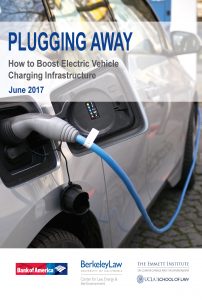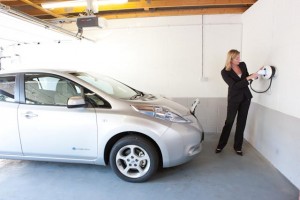The electric vehicle revolution appears to be passing renters by. And the solution involves deploying more charging stations.
In a new working paper and blog by UC Berkeley energy economist Lucas Davis, he finds that homeowners are much more likely than renters to own an EV, even with similar incomes. He found, for example, that among households with incomes between $75,000 and $100,000 per year, 1 in 130 homeowners owned an EV, while only 1 in 370 renters owned one.
Why the discrepancy? As Davis explains, it’s about access to charging:
Most homeowners have a garage, a driveway or both. That makes charging extremely convenient for them because they can charge their vehicles at night.
It’s not so easy, however, for many renters. Renters are more likely to live in multi-unit buildings and parking spots may not be assigned, or there may not be any parking spots at all. The federal data doesn’t provide any information about parking availability, but this likely helps explain the disparity between homeowners and renter EV ownership rates.
There is also the related question of charging equipment. For homeowners, it is relatively straightforward to invest in a 240-volt outlet, electric panel upgrades and other improvements to speed up charging. These investments can cost $1,000 or more, but are a good investment for a homeowner planning to stay put.
Making this investment is trickier for renters, however. They may not want to invest their own money in a property they don’t own and their landlords may be unwilling to let them do it in any case due to liability and other concerns.
 The best solution is to deploy more EV charging stations at workplaces and in fast-charging “plazas,” as we described in our 2017 Berkeley / UCLA Law report Plugging Away.
The best solution is to deploy more EV charging stations at workplaces and in fast-charging “plazas,” as we described in our 2017 Berkeley / UCLA Law report Plugging Away.
And more charging stations are needed not just for apartment dwellers and renters but to meet our climate goals more generally. In a recent report by the Center for American Progress, the authors found that most states in the U.S. have funded less than half of the deployment needed to meet our Paris climate accord commitment.
As E&E News reported on the study [paywalled]:
The analysis found that some 330,000 new public Level 2 and direct-current fast-charging stations would need to go up around the country by 2025.
At a cost of $4.7 billion, those networks would feed power to the 14 million plug-in hybrids and battery electrics necessary to bring greenhouse gas emissions from light-duty cars in line with the accord.
It’s a lot of money that’s needed — but also potentially a lot of revenue from selling electricity as vehicle fuel. With more utility and potentially automaker investment, this infrastructure goal should be feasible to achieve, if we muster the political will.
It’s commonly understood that the lack of electric vehicle charging stations is a significant barrier to consumer adoption. Whether you live in an apartment without a dedicated parking spot or a single-family home and need to charge quickly on longer road trips, the infrastructure availability can make or break decision-making.
But it’s less understood among even electric vehicle drivers themselves how complicated charging can be, in terms of the multiple formats and charging speeds. First, the good news: the U.S. now has 47,114 public EV charging outlets, up from 25,602 at the end of 2014, per the U.S. Department of Energy.
But here’s the problem, as E&E news covered [pay-walled]:
But they’re not all the same, and not all cars can use them all. Tesla Inc.’s Supercharger Network, for example, only works for Tesla drivers. Charging at home on a Level 1 or 2 charger can take all night; charging at a public fast-charging station can take 30 minutes or less, depending on the power provided and technology.
One of the key technology developments has been increasing the power — and speed — of the charging stations. Tesla’s Supercharger Network of 8,496 stations provides up to 120 kilowatts per car, but it is proprietary.
Other automakers have increased the capacity of their latest models, and an increasing number of stations are planning to deliver more than 100 kW, a change from the earlier 50 kW. ChargePoint Inc. has developed a 400-kW charging technology. EVgo, another charging company, is installing up to dozens of high-powered fast-charging stations of 145 to 350 kW. Automakers and technology startups have developed technology that would fully charge a car in five minutes or less, although it’s not yet widely available.
All these numbers can be confusing, and really people just want a simple answer to the question: how long will it take me to charge my battery? Here’s how I like to explain it to the average person:
- “Level 1” (or your standard wall outlet) will charge your car about 5 miles per hour. The formats are the same across all vehicles.
- “Level 2” (or 240 volts, like for a large home appliance) has more variability, but generally will give you about 20 miles per hour. The formats are also the same across all vehicles. But the variability in charging speed can be fairly significant, due to the divergent amperage (or “amps,” measuring essentially the volume of the electric current) allowed by various batteries and charging stations. Here are the three big examples of differing charging speeds just within Level 2:
- If you can only Level 2 charge at 16 amps, that’s total power of 3.8 kilowatts (you multiply 240 volts by amps for total power). At that speed, with a Chevy Bolt EV’s 60 kilowatt-hour battery, it would take you 15.8 hours to fully charge from zero (60 divided by 3.8). With 238 mile range, that equals 15 miles per hour.
- If the battery could accept 32 amps, that equals 7.6 kilowatts of power at the Level 2 charging station, which means the Chevy Bolt would charge fully from zero in 7.9 hours. That equals 30 miles per hour.
- And if your battery could accept 48 amps (like all Teslas do), you could fully charge at 11.5 kilowatts in 5.2 hours, or 45 miles per hour. So 5.2 hours to 15.8 hours is a huge range, just within Level 2.
- “Fast Charge” has the most variability and also three incompatible formats across North American/European, Asian and Tesla vehicles. As the article above mentioned, most fast chargers have 50 kilowatts of power. That means you could charge your Chevy Bolt EV in a bit over an hour (60 kilowatt hours divided by 50 kilowatts), although really less than that because the car is programmed to charge at a reduced speed for the last 80% to minimize harm to the battery. So I’d bank on about two hours, or 120 miles per hour, for a full charge from zero in a 50 kilowatt fast charger. Tesla fast-chargers are much quicker at 120 kilowatts, meaning your Chevy Bolt EV (which can’t use those chargers but just for the sake of calculation) could charge closer to 30 or 40 minutes, or 200 miles in 30 minutes (although slower given the last 20% slowdown I just mentioned). And at 350 kilowatts, you could charge your Chevy Bolt EV like you are at a gas station, in perhaps just 20 minutes.
So we need more 350 kilowatt chargers, and we need them all over major interstate corridors and in urban “plazas” for apartment dwellers. We covered some solutions for this deployment in the report Plugging Away last year.
And hopefully one day charging will be so simple and ubiquitous that nobody will need to bother with all the calculations and explanations I’ve offered here.
 I’ve been an advocate for letting electric utilities build electric vehicle charging stations for a while now. While nobody likes the ideas of regulated monopolies taking over a market, the fact is that private companies are not getting the job done, and there aren’t sufficient charging stations to meet growing demand and to enable longer-distance electric travel.
I’ve been an advocate for letting electric utilities build electric vehicle charging stations for a while now. While nobody likes the ideas of regulated monopolies taking over a market, the fact is that private companies are not getting the job done, and there aren’t sufficient charging stations to meet growing demand and to enable longer-distance electric travel.
So I’ve been following with interest Pacific Gas & Electric’s (PG&E) proposal to serve the 65,000 EV drivers in its Northern California service territory with 25,100 charging stations (the number that may be necessary to meet Governor Brown’s goal of having one million EVs on the road by 2020).
But the California Public Utilities Commission would like to go slower than that, as Charged EVs reports:
[T]he state Public Utilities Commission has put a stop to PG&E’s dreams of empire for the moment, saying that it will need to hold a series of hearings before authorizing the program.
“We must consider the requirement to protect against unfair competition and the demonstrated costs and benefits of any utility electric vehicle charging station proposal,” PUC Commissioner Carla Peterman wrote in her ruling (via San Jose Mercury News). “We find that a more measured approach to utility ownership in PG&E’s service territory is warranted.”
One objection to PG&E’s plan is the cost: $654 million, which the utility plans to pass on to ratepayers. Under the original PG&E proposal, residential electricity customers would pay an additional 70 cents per month on their utility bills from 2018 to 2022.
Peterman also pointed out concerns that control of such a comprehensive network could give PG&E something of a monopoly. The utility’s plan calls for it to have control over the design and support of the charging facilities, something that other companies in the charging industry say could suppress innovation.
I think this approach could make sense. It may be best to go slow on the roll out to see how the market reacts. The CPUC could also ensure that the initial utility stations are located where there is no strong market incentive for private companies to site them. Ideally the state could end up with a hybrid system of some utility-owned stations and some private company-owned ones. The other possibility is that PG&E provides some of the underlying infrastructure for the stations, while charging companies then compete to set up chargers in those locations.
Either way, I imagine this is only the first step on a path to more utility-owned charging stations, and the result will hopefully be better coverage and convenience for EV drivers.


